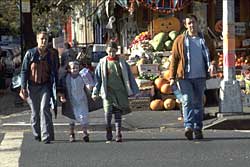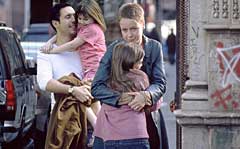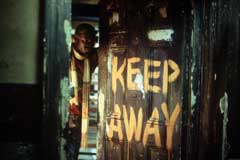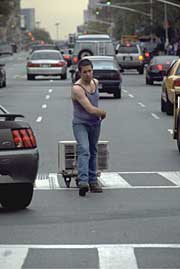|
|
Family Bonds:
Jim Sheridan's In America
 Morton and Considine with the Bolgers
Morton and Considine with the Bolgers |
December 4, 2003 | New York City rises from the ether of possibility at the beginning of
writer/director Jim Sheridan’s In America, presenting itself as a
colorful beacon of hope to an Irish immigrant family. As scored and cut
to the rhythms of The Lovin’ Spoonful’s "Do You Believe in Magic," this
opening montage effectively announces Sheridan’s fanciful, yet honestly
emotional, intentions. New York is as magical here as was Steven
Spielberg’s everywhere suburbia in E.T.: The Extra-Terrestrial (1982).
It’s no surprise then that E.T. and Spielberg are two of In America’s
cultural touchstones.
Certain critics have placed In America’s story within the early 1980s,
ostensibly because of autobiographical import (Sheridan, a struggling
artist, and his family lived in New York around that time) in addition
to a scene in which husband Johnny (Paddy Considine) and wife Sarah
(Samantha Morton) take daughters Christy (Sarah Bolger) and Ariel (Emma
Bolger) to a summertime screening of E.T. In truth, In America never
definitively mentions its time period, forcing the film to be viewed,
like E.T. and its numerous re-issues, through a timeless prism.
 Family Bonds
Family Bonds |
Sheridan finds the tragic, mercantile poetry of Spielberg’s fantasia in
a revelatory carnival scene where Johnny attempts to win his youngest
daughter Ariel an E.T. doll. The victory carrot dangling, Johnny bets
more and more of his family’s money, recklessly giving over to
capitalist chance in an effort to satiate familial desire. Here, in a
metaphorical nutshell, is the outsider’s struggle in the land of the
free. The scene’s outcome hinges on a wish by eldest
daughter
Christy to the family’s deceased brother Frankie, victim of a
debilitating brain tumor. Christy’s faith silently strengthens the
family bonds, setting up her later, gut-wrenching admission that "I’ve
been carrying this family on my back" and providing In America with its
redemptive Christian backbone.
 Honsou - "The man who screams"
Honsou - "The man who screams" |
Sheridan visualizes this redemption symbolically through several
cinematic interplays. Christy’s propensity for videotaping certain
intimate moments helps to delineate between her family’s hopeful outer
fantasies and their tortured inner realities. Johnny is stripped bare
in
one of these moments when a newly pregnant Sarah asks him if he can
feel
their unborn baby kicking. "No," he states bluntly within his
daughter’s
camcorder viewfinder before walking off. Sheridan uses video here to
point out film’s singular inadequacy at capturing emotional reality
beyond the broadest strokes. It’s only through the faithful use of the
tools of our trade (be we fathers or filmmakers) that the depths
emerge.
Filmmaking equals faith for both Christy and Sheridan, and both take
the
burden of familial/story redemption on their shoulders.
 Considine - "I’ve been carrying
Considine - "I’ve been carrying
this family on my back" |
Key to the journey is the family’s relationship with Mateo (Djimon
Hounsou), a reclusive artist living in their tenement building and
dying
of an unspecified disease. There has been some valid questioning of
Sheridan’s intentions here. On paper, the black artist helping the
white
family see the light rightly seems a hoary, racist cliché. But this is
to sorely misread Sheridan’s final product, as well as Hounsou’s expert
performance. Recall again the Spielberg connection: Hounsou starred as
the imprisoned slave Cinque in Amistad (1997), speaking that film’s
heart through simple dialogue. ("Give us free!") Hounsou’s reading of
that line, coupled with his inherently cinematic physical presence,
effectively broke down racial, and racist, barriers. The same applies
here.
Mateo is introduced first as a threatening, primal voice – "The man who
screams," says a building resident. Starting from this place of
disassociation, Sheridan breaks down the self-imposed boundaries in a
sequence of parallel psychic connection. Recalling the audacious
letters
scene of Spielberg’s The Color Purple (1985), Sheridan intercuts Johnny
and Sarah’s lovemaking with Mateo’s frenzied destruction of his
artwork.
"That was the night the baby was conceived," says Christy in
voice-over,
thus acknowledging the destructive impulse intrinsic to any act of
creation and subtly suggesting Mateo’s climactic transubstantiation.
It is to Hounsou’s credit that he gives this role, undoubtedly and
unavoidably thin on the page, a necessary layer of humanity. Indeed, it
is through In America’s basic underlying theme of faith that this
character’s conception becomes justifiable. Truly, some people in life
are walking metaphors to whom we feel an inextricable connection. Both
Hounsou and Sheridan profoundly visualize this idea while keeping full
sight of Mateo’s soul. It is therefore in no way mawkish or unearned
when Mateo, on his deathbed, compares himself to E.T. It could be
argued
that illness helps to open one’s mind to the simplest of metaphors.
Faced with inevitability we are forced to drop the pretense and
genuinely connect with those around us. Sheridan and Hounsou find the
expressive joy in the body’s painful destruction. The end result is In
America’s concluding image: A glorious close-up of a full moon that
belongs not only to Mateo, Sheridan, and Spielberg/E.T., but to all of
us. In this moment, the poetry of an individual soul becomes the art of
the universe.
In America is currently playing in select theaters and will expand throughout December. Click here for a list of current and upcoming theaters.
Archives
|
|

